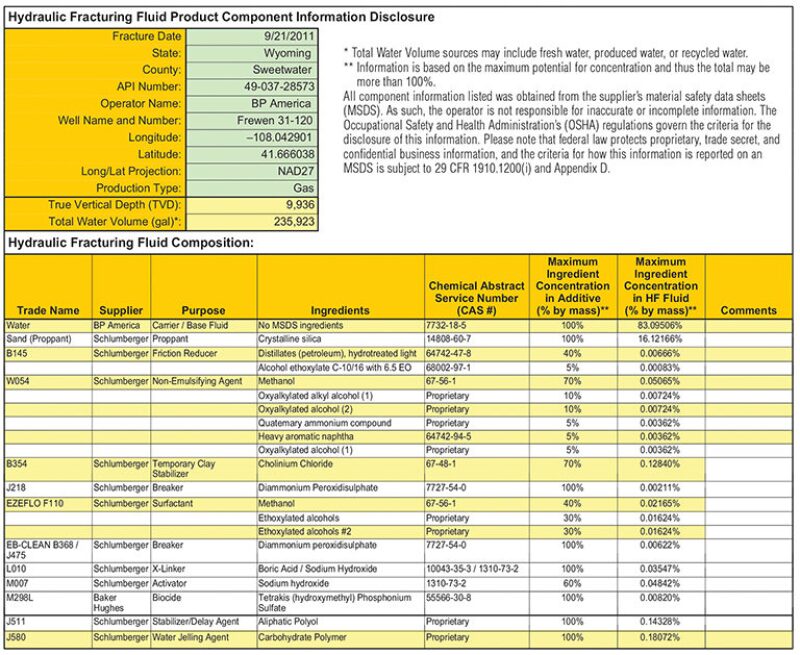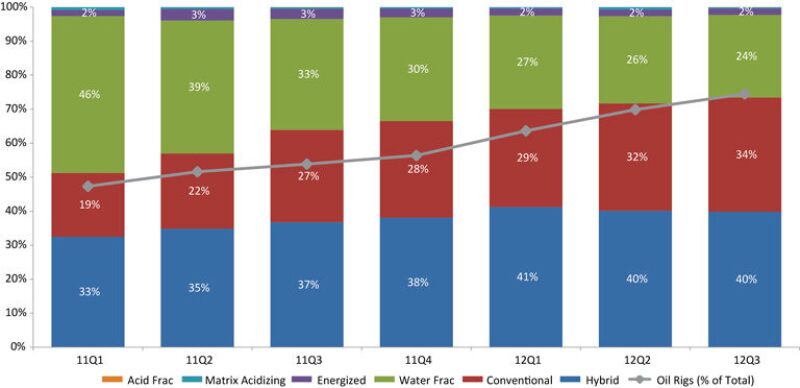An analysis of thousands of fracturing treatments in major plays in the United States provides insights into how fracture designs have changed over time. All available data from FracFocus.org were collected, and each fracture treatment was classified into a set of standard hydraulic-fracturing-treatment types. This analysis of changes identifies changes over time in fracture type on the basis of seven broad categories—conventional, water frac, hybrid, energized, acid frac, gas frac, and matrix acidizing.
Introduction
FracFocus.org was launched in early 2011 to serve as the US national hydraulic-fracturing chemical registry. The registry is managed by the Groundwater Protection Council and the Interstate Oil and Gas Compact Commission to provide the public with access to reported chemicals used for hydraulic fracturing within their area. When this paper was written, nearly 26,000 wells had been reported on the website.
Although the FracFocus website was developed with the intention of disclosing to the public the chemicals injected downhole within a given area, the chemical-disclosure data sheets contain a wealth of technical data about hydraulic-fracturing-fluid systems.
Every FracFocus chemical-disclosure data sheet contains basic information about the well that was fractured, including date, latitude/longitude, true vertical depth, and water volume. In addition, the data sheet contains detailed information about every additive injected downhole during the hydraulic fracturing, including trade name, purpose, supplier, ingredients, chemical abstract service number, maximum ingredient concentration in additive, and maximum ingredient concentration in hydraulic-fracturing fluid (Fig. 1). See Table 1 for the system developed to characterize hydraulic-fracturing treatments.


Analysis of Aggregate US Fracturing-Fluid-System Trends
Aggregate fracture trends in the US had shifted dramatically in the 18 months before this paper was written. Drilling and completion activity shifted quickly from a heavy focus on gas plays to oil and liquids-rich plays. In the first week of 2011, 54% of all active land rigs operating in the US were targeting gas, compared with only 24% in the last week of the third quarter of 2012, a decline of more than 50%.
At the US aggregate level, fracture-type trends very closely reflect the shift from gas- to oil-focused drilling and completion activity. In the first quarter of 2011, water fracs represented 46% of all hydraulic-fracturing treatments undertaken in the US. By the third quarter of 2012, water fracs represented only 24% of hydraulic-fracturing treatments, a decrease of nearly 50%. This decrease was roughly proportional to the fall in the gas rig count over the same time period. In contrast, conventional fracs increased from 19 to 34% of all hydraulic-fracturing treatments from the first quarter of 2011 to the third quarter of 2012. In the same time period, hybrid fracs increased from 33 to 40% of all hydraulic-fracturing treatments (Fig. 2).

Water consumption during hydraulic-fracturing treatments has also exhibited clear trends since early 2011. The average volume of water consumed as part of a hydraulic-fracturing treatment decreased by 11% from the first quarter of 2011 to the third quarter of 2012, from 63,382 to 56,537 bbl. The decrease in average water consumption is primarily because of a shift away from water-frac technology toward conventional- and hybrid-frac technology. During the same time period, average water volume consumed during hybrid-frac treatments decreased by 22%, from 81,324 to 63,802 bbl. In contrast, average water volume consumed during water fracs increased by 26% from the first quarter of 2011 to the third quarter of 2012, from 68,710 to 86,858 bbl. Although the shift in average water consumption is driven mostly by the shift away from water fracs, there are also distinct shifts in consumption occurring within each fracture type.
These shifts in fracturing-fluid-system trends are likely the result of operators gaining a better understanding of the drivers behind production and of the cost to complete wells in the unconventional plays being targeted. There are major differences in the type and volume of chemicals used in different fracturing-fluid technologies and the volume of water required. These differences, along with the use of a sleeve technology instead of a perforate-and-plug approach, have a major effect on the use of additives across all plays.
Analysis of Regional Fracturing-Fluid-System Trends
Denver-Julesburg (DJ) Basin. There has been a dramatic shift in fracture design in the DJ basin. An analysis of all completion activity reveals that the percentage of water fracs has dropped from 68% in the first quarter of 2011 to 12% in the third quarter of 2012, while the percentage of hybrid fracs has increased from 27 to 79% in the same time period. The majority of fracturing treatments in the DJ basin are small, (defined as less than 16,500 bbl of water for the purposes of this paper), though the percentage of small fracturing treatments has decreased from 95% in January 2012 to 70% in August 2012. Reproducing the analysis across small fracturing jobs, the percentage of water fracs has decreased from 72% in the first quarter of 2011 to 17% in the third quarter of 2012, while hybrid fracs have increased from 25 to 76% in the same time period.
There has been a dramatic decline in the use of clay-control additives in the DJ basin, declining from 88% of wells in the first quarter of 2011 to less than 48% of wells in the second quarter of 2012. The use of surfactant has also declined, but less severely, from 96 to 85% over the same time period, with most of the decrease appearing during the first and second quarter of 2012.
Bakken. The most significant trend in fracture design in the Bakken has been an increase in the proportion of hybrid fracs, at the expense of conventional fracs. The proportion of conventional fracs decreased from 90% of wells in the first quarter of 2011 to 55% of wells in the third quarter of 2012 (among large fracturing treatments, defined as greater than or equal to 16,500 bbl of water for the purpose of this paper), with most of the decrease taking place in the third quarter of 2011 and the first quarter of 2012. A second trend worth noting is the appearance of water fracs beginning in March 2012, increasing to 9% of total wells in the Bakken in the second quarter of 2012.
Except for a few hybrid jobs in the first quarter of 2011, hybrid and conventional treatments in the Bakken have generally consumed similar volumes of water, typically between 40,000 and 50,000 bbl. However, with the appearance of water fracs in early 2012, average fracturing-treatment size in the Bakken has increased from 45,540 bbl in the first quarter of 2011 to 57,817 bbl in the third quarter of 2012.
The use of clay-control agents in the Bakken increased from 25% in the first quarter of 2011 to 37% in the second quarter of 2012. Surfactant usage decreased from 71 to 45% in the same period.
Eagle Ford. Hybrid fracs are the predominant fracture technology in the Eagle Ford, averaging roughly 65% for the second half of 2011 and for the part of 2012 for which data are available. However, it is important to note that, from January 2011 to June 2011, the proportion of hybrid fracs pumped in the Eagle Ford decreased from 83% of all wells to 63% of all wells, a dramatic shift in fracture design. The remaining fracture activity is split between water fracs and conventional fracs, with a nearly equal proportion of each pumped in the second and third quarters of 2012.
Eagle Ford hydraulic-fracturing treatments are generally larger than those undertaken in most other plays, with the average treatment averaging more than 100,000 bbl of water in the third quarter of 2012, compared with slightly more than 50,000 bbl in the aggregate US in the same time period.
Eagle Ford fracturing fluids have also seen a decline in specialty chemicals. The use of clay-control agents decreased from 62% of wells in the first quarter of 2011 to 35% of wells in the second quarter of 2012. Surfactant usage has seen a similar, though less dramatic, decline—from 60 to 42% of wells in the same period. The use of both decreased consistently until 2012, at which point usage plateaued.
Conclusions
The analysis of thousands of fracturing treatments in the major unconventional plays in the United States provides meaningful insights into how fracturing-fluid-system trends have changed across time. Aggregate fracturing trends in the United States have shifted dramatically in the last 18 months.
Drilling and completion activity has shifted quickly from a heavy focus on gas plays to oil and liquids-rich plays. This paper shows that this trend can also be seen in the use of different fracturing-fluid technologies: The use of hybrid- and conventional-frac technology has increased significantly over the last 18 months at the expense of water-frac technology.
This article, written by Special Publications Editor Adam Wilson, contains highlights of paper SPE 163875, “Analysis of US Hydraulic-Fracturing-Fluid-System Trends,” by Christopher Robart, SPE, PacWest Consulting Partners, Michael Ruegamer, SPE, Kingsfield Consulting, and Alex Yang, PacWest Consulting Partners, prepared for the 2013 SPE Hydraulic Fracturing Technology Conference, The Woodlands, Texas, USA, 4–6 February. The paper has not been peer reviewed.
